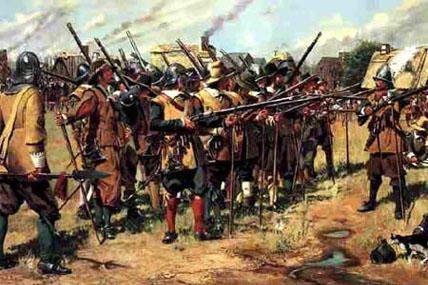The National Guard traces its history back to the earliest English colonies in North America. Responsible for their own defense, the colonists drew on English military tradition and organized their able-bodied male citizens into militias. When the Guard's oldest regiments met for their first drill on the village green in Salem, Massachusetts, they were barely three months old, organized on December 13th, 1636, the date we now celebrate as the National Guard birthday.
In 1637, the English settlements in North America were a tiny fringe along the Eastern seaboard. As settlement pushed west into the interior, the institution of the militia, which the colonists brought with them from England, went with them. The militia tradition meant citizens organizing themselves into military units, responsible for their own defense. Organizing the militia into regiments increased its efficiency and responsiveness, which proved critical for the defense of their communities. Its oldest units are the oldest units in the United States military and among the oldest military units in the world.
The militia, called the National Guard since 1916, has served community, state, and nation for nearly 400 years, and citizen-soldiers have fought in every major American conflict from 1637 to present day operations in Afghanistan and Iraq. Much has changed since the "first muster," but more than 370 years later, the men and women of the National Guard are still defending their neighbors – and their nation.
The Guard doubled the size of the Regular Army when it was mobilized in 1940, more than a year before Pearl Harbor, and contributed 19 divisions to that war, as well as numerous other units including Guard aviation squadrons. More than 138,000 Guardsmen were mobilized for Korea, followed by numerous smaller mobilizations for the Berlin Crisis, Vietnam, and numerous strikes and riots at home. Approximately 63,000 Army Guardsmen were called to serve in Desert Storm, and in the decade since then Guardsmen have seen a greater role than ever before -- conducting peacekeeping in Somalia, Haiti, Saudi Arabia and Kuwait, Bosnia, and Kosovo. Following the attacks of September 11, 2001, Guardsmen were called up by both their States and the Federal government to provide security at home and combat terrorism abroad. Today, in additional to its usual state-side requirements and OCONUS peace-keeping missions, the Army National Guard is heavily engaged in both Iraq and Afghanistan.
Today's National Guard continues its historic dual mission, providing the states with units trained and equipped to protect life and property, while providing the nation with units ready to defend the United States and its interests around the world.
The citizen-soldiers who make up the National Guard have fought in every major American war since 1637. War has changed a great deal, and today's Guard must be prepared to fight in a high-technology environment, using complex weapons and equipment. The men and women of today's Guard are ready to become full-time professional soldiers if the need arises, whether for federal or state missions just as they did in 1637.
